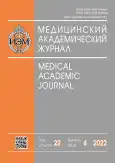Comparative morphometric analysis of contents mononuclear cells in unstable and in stable atherosclerotic lesions
- Authors: Pigarevsky P.V.1, Snegova V.A.1, Maltseva S.V.1, Davydova N.G.1, Yakovleva O.G.1, Denisenko A.D.1
-
Affiliations:
- Institute of Experimental Medicine
- Issue: Vol 22, No 4 (2022)
- Pages: 15-21
- Section: Original research
- Published: 01.02.2023
- URL: https://journals.eco-vector.com/MAJ/article/view/108866
- DOI: https://doi.org/10.17816/MAJ108866
- ID: 108866
Cite item
Abstract
BACKGROUND: Recent research results indicate that inflammatory cellular responses can play a significant role in the pathogenesis of atherosclerosis in humans and experimental animals, with a predominance in infiltrates of lymphocytes and monocytes/macrophages that contribute to destructive processes in the vascular wall. However, no comparative, differentiated morphometric analysis of the content of mononuclear cells in unstable and stable atherosclerotic lesions has been carried out so far.
AIM: Carrying out comparative histological and morphometric examination of quantitative content of lymphocytes and macrophages in normal vascular wall, in lipid stain, in unstable and in stable atherosclerotic lesions.
MATERIALS AND METHODS: The study material was samples taken during 15 autopsies aged 56 to 71 years who died from acute cardiovascular failure of atherosclerotic etiology. A comparative histological and morphometric study of the content of mononuclear cells: lymphocytes and macrophages in normal areas of the vascular wall, in lipid stains, in unstable and stable atherosclerotic lesions was carried out — a total of 50 tissue samples stained with hematoxylin and eosin.
RESULTS: A sharp increase in the content of studied cells in intima, atheromatous nucleus and adventition in unstable atherosclerotic plaques was revealed. In normal areas of the vascular wall, in initial atherosclerotic lesions and in stable plaques, the number of macrophages and lymphocytes is small.
CONCLUSIONS: In general, the results obtained are well consistent with the literature and suggest in favor of the need for lymphocytes and macrophages to form immuno-inflammatory reactions in the formation of unstable atherosclerotic lesions in humans.
Full Text
About the authors
Peter V. Pigarevsky
Institute of Experimental Medicine
Author for correspondence.
Email: pigarevsky@mail.ru
ORCID iD: 0000-0002-5906-6771
SPIN-code: 8636-4271
Scopus Author ID: 55404484800
ResearcherId: C-3425-2014
Dr. Sci. (Biol.), Head, Department of General Morphology
Russian Federation, Saint PetersburgVlada A. Snegova
Institute of Experimental Medicine
Email: biolaber@inbox.ru
ORCID iD: 0000-0002-9925-2886
SPIN-code: 8088-4446
Scopus Author ID: 55822129200
ResearcherId: C-9392-2012
Research Associate, Department of General Morphology
Russian Federation, Saint PetersburgSvetlana V. Maltseva
Institute of Experimental Medicine
Email: moon25@rambler.ru
ORCID iD: 0000-0001-7680-8485
SPIN-code: 8367-9096
Scopus Author ID: 6602920398
Cand. Sci. (Biol.), Senior Research Associate, Department of General Morphology
Russian Federation, Saint PetersburgNatalya G. Davydova
Institute of Experimental Medicine
Email: tatashaspb@yandex.ru
ORCID iD: 0000-0002-4522-6789
SPIN-code: 4761-3575
МD, Cand. Sci. (Med.), Senior Research Associate, Department of General Morphology
Russian Federation, Saint PetersburgOlga G. Yakovleva
Institute of Experimental Medicine
Email: emalonett@yandex.ru
ORCID iD: 0000-0002-6248-9468
Scopus Author ID: 36020553000
ResearcherId: J-6004-2018
Research Associate, Department of General Morphology
Russian Federation, Saint PetersburgAlexander D. Denisenko
Institute of Experimental Medicine
Email: add@iem.sp.ru
ORCID iD: 0000-0003-1613-0654
SPIN-code: 7496-1449
ResearcherId: G-4774-2015
МD, Dr. Sсi. (Med.), Professor, Head of the Laboratory for the Regulation of Lipid Metabolism, Department of Biochemistry
Russian Federation, Saint PetersburgReferences
- Kakturskii LV. Clinical morphology of acute coronary syndrome. Arkhiv patologii. 2007;69(4):16–19. (In Russ.)
- Pigarevskiy PV, Maltseva SV, Snegova VA. Progressiruyushchie ateroskleroticheskie porazheniya u cheloveka. Morfologicheskie i immunovospalitel’nye aspekty. Cytokines and inflammation. 2013;12(1–2):5–12. (In Russ.)
- Shah PK, Wang L, Sharifi B. New insights into molecular mechanisms of plaque instability. Atherosclerisis. 2006;7(3):156–157. doi: 10.1016/S1567-5688(06)80612-4
- Pigarevsky PV, Maltseva SV, Snegova VA, Davydova NG. The role of interleukin-18 in the destabilization of atherosclerotic plaque in humans. Bulletin of Experimental Biology and Medicine. 2014;157(6):821–824. doi: 10.1007/s10517-014-2675-x
- Todorov SS, Deribas VYu, Sidorov RV, et al. Morphological features of the structure of unstable atherosclerotic plaques of the coronary arteries of the heart. Modern problems of science and education. 2021;(4):92–102. (In Russ.) doi: 10.17513/spno.31054
- Nagornev V, Anestiadi V, Zota E. Patomorfoz ateroskleroza (immunoaspekty). Saint Petersburg: Kishinev; 2008. (In Russ.)
- Pigarevsky PV. Antigens and their role in immune-inflammatory reactions during atherogenesis in humans. Medical Academic Journal. 2010;10(4):210–217. (In Russ.)
- Tse K, Tse H, Sidney J, et al. T cells in atherosclerosis. Int Immunol. 2013;25(11):615–622. doi: 10.1093/intimm/dxt043
- Pigarevsky PV, Snegova VA, Maltseva SV, Davydova NG. T-limphocytes and macrophages in unstable human atherosclerotic lesions. Cytokines and inflammation. 2015;14(2):84–87. (In Russ.)
- Abdolmaleki F, Hayat S, Bianconi V, et al. Atherosclerosis and immunity: a perspective. Trends Cardiovasc Med. 2019;29(6):363–371. doi: 10.1016/j.tcm.2018.09.017
- Cimmino G, Loffredo FS, Morello A, et al. Immune-inflammatory activation in acute coronary syndromes: a look into the heart of unstable coronary plaque. Curr Cardiol Rev. 2017;13(2):110–117. doi: 10.2174/1573403X12666161014093812
- Kubatova H, Poledne R, Pitha J. Immune cells in carotid artery plaques: what can we learn from endarterectomy specimens? Int Angiol. 2020;39(1):37–49. doi: 10.23736/S0392-9590.19.04250-0
Supplementary files











